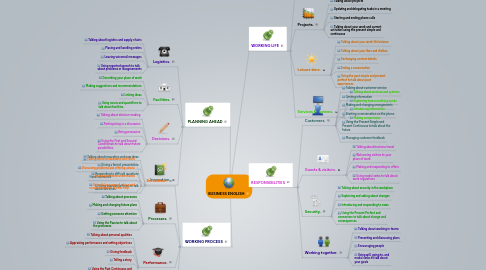
1. PLANNING AHEAD
1.1. Logistics.
1.1.1. Talking about logistics and supply chains
1.1.2. Placing and handling orders
1.1.3. Leaving voicemail messages
1.1.4. Using reported speech to talk about problems or disagreements
1.2. Facilities.
1.2.1. Describing your place of work
1.2.2. Making suggestions and recommendations
1.2.3. Linking ideas
1.2.4. Using nouns and quantifiers to talk about facilities
1.3. Decisions.
1.3.1. Talking about decision-making
1.3.2. Participating in a discussion
1.3.3. Being persuasive
1.3.4. Using the First and Second Conditionals to talk about future possibilities
1.4. Innovation.
1.4.1. Talking about innovation and new ideas
1.4.2. Giving a formal presentation
1.4.3. Responding to difficult questions and comments
1.4.4. Using superlative forms to talk about extremes
2. WORKING PROCESS
2.1. Breakdown.
2.1.1. Talking about breakdowns and faults
2.1.2. Discussing problems and offering advice
2.1.3. Checking someone understands
2.1.4. Using th language of advice and recommendation to offer help
2.2. Processes.
2.2.1. Talking about processes
2.2.2. Making and changing future plans
2.2.3. Getting someone attention
2.2.4. Using the Passive to talk about the processes
2.3. Performance.
2.3.1. Talking about personal qualities
2.3.2. Appraising performance and setting objectives
2.3.3. Giving feedback
2.3.4. Telling a story
2.3.5. Using the Past Continuous and Past Perfect to talk about past events
2.4. Success.
2.4.1. Talking about achievements
2.4.2. Reporting back on and evaluating research
2.4.3. Generalizing
2.4.4. Using contrasting language
3. WORKING LIFE
3.1. Working life. Companies.
3.1.1. Talking about your work and responsiblities
3.1.2. Introducing yourself and others
3.1.3. Expressing interest in conversations
3.1.4. Using the present simple and frequency adverbs to talk about your job and routine activities
3.2. Projects.
3.2.1. Talking about projects
3.2.2. Updating and delegating tasks in a meeting
3.2.3. Starting and ending phone calls
3.2.4. Talking about your work and current activities using the present simple and continuous
3.3. Leisure time.
3.3.1. Talking about your work-life balance
3.3.2. Talking about your likes and dislikes
3.3.3. Exchanging contact details
3.3.4. Ending a conversation
3.3.5. Using the past simple and present perfect to talk about past experiences
3.4. Services & systems.
3.4.1. Talking about services and systems
3.4.2. Explaining how something works
3.4.3. Introducing information
3.4.4. Making comparisons
4. RESPONSIBILITIES
4.1. Customers.
4.1.1. Talking about customer service
4.1.2. Getting information
4.1.3. Making and changing arrangements
4.1.4. Starting a conversation on the phone
4.1.5. Using the Present Simple and Present Continuous to talk about the future
4.1.6. Managing customer feedback
4.2. Guests & visitors.
4.2.1. Talking about business travel
4.2.2. Welcoming visitors to your place of work
4.2.3. Making and responding to offers
4.2.4. Using modal verbs to talk about work regulations
4.3. Security.
4.3.1. Talking about security in the workplace
4.3.2. Explaining and asking about changes
4.3.3. Introducing and responding to news
4.3.4. Using the Present Perfect and connectors to talk about change and consequences
4.4. Working together.
4.4.1. Talking about working in teams
4.4.2. Presenting and discussing plans
4.4.3. Encouraging people
4.4.4. Using will, going to, and modal verbs to talk about your goals
